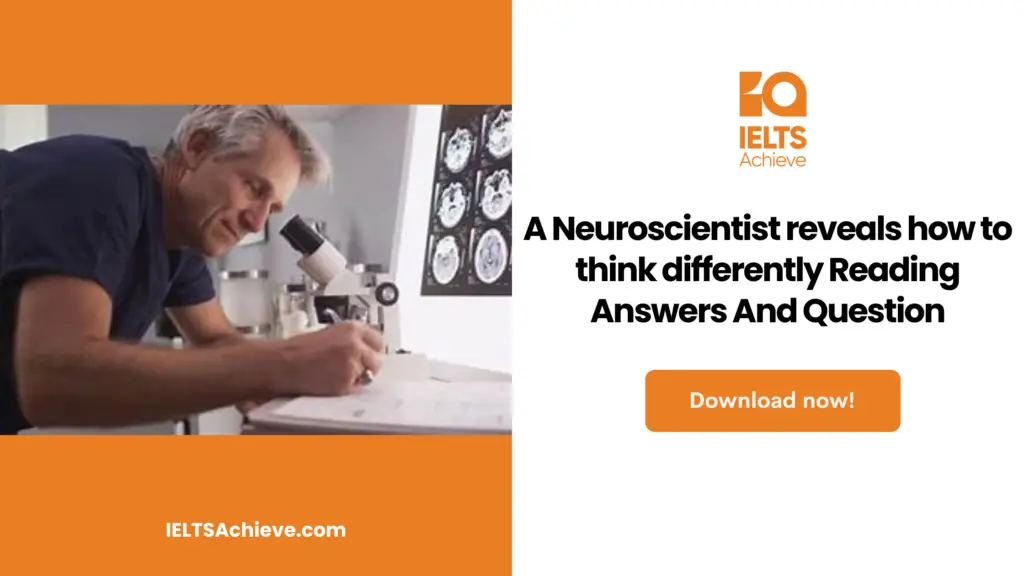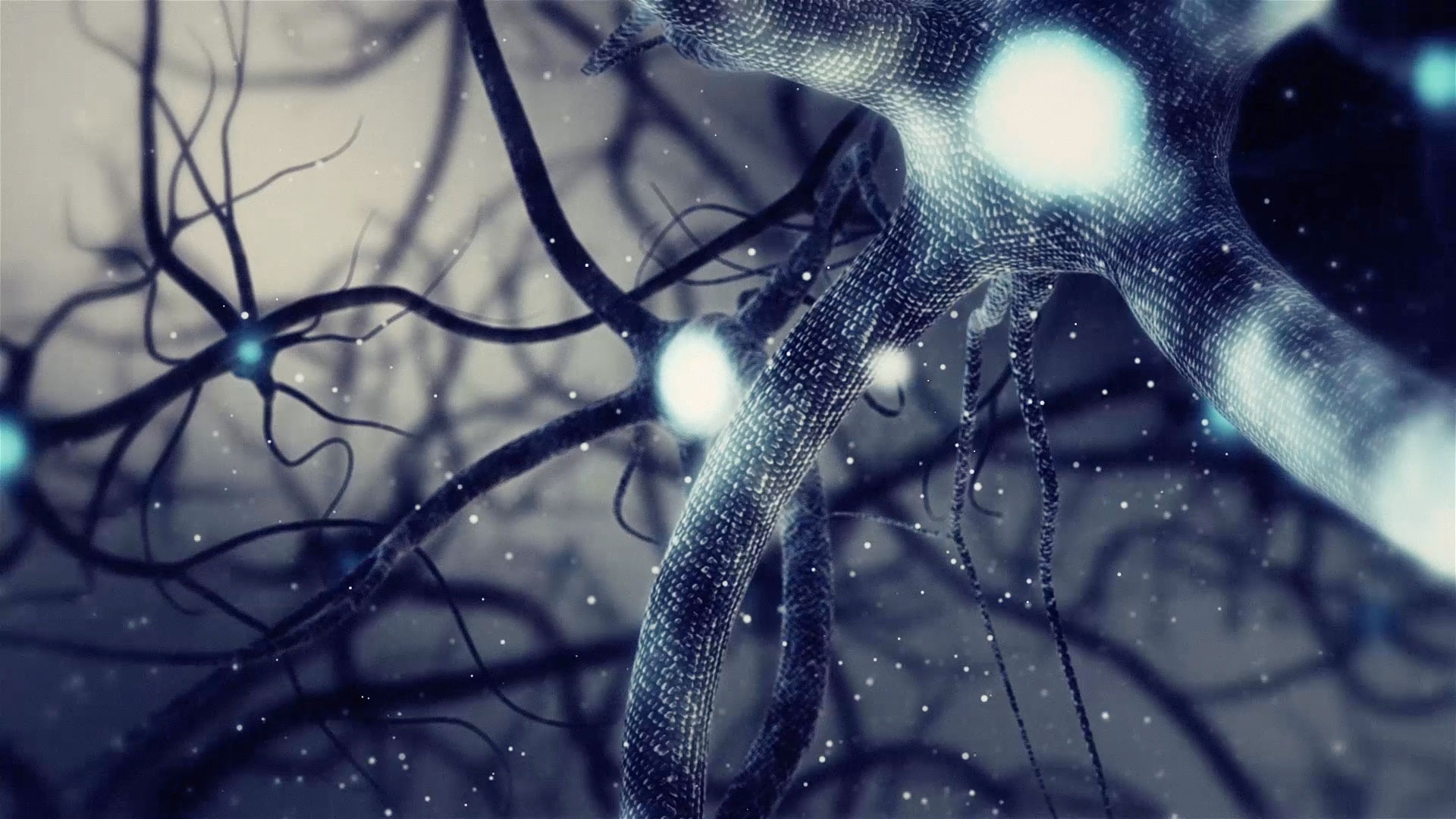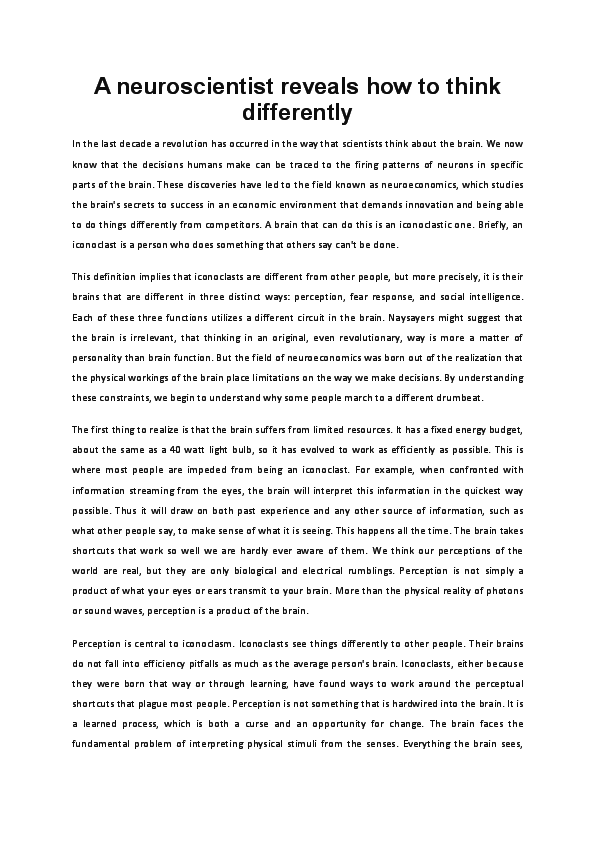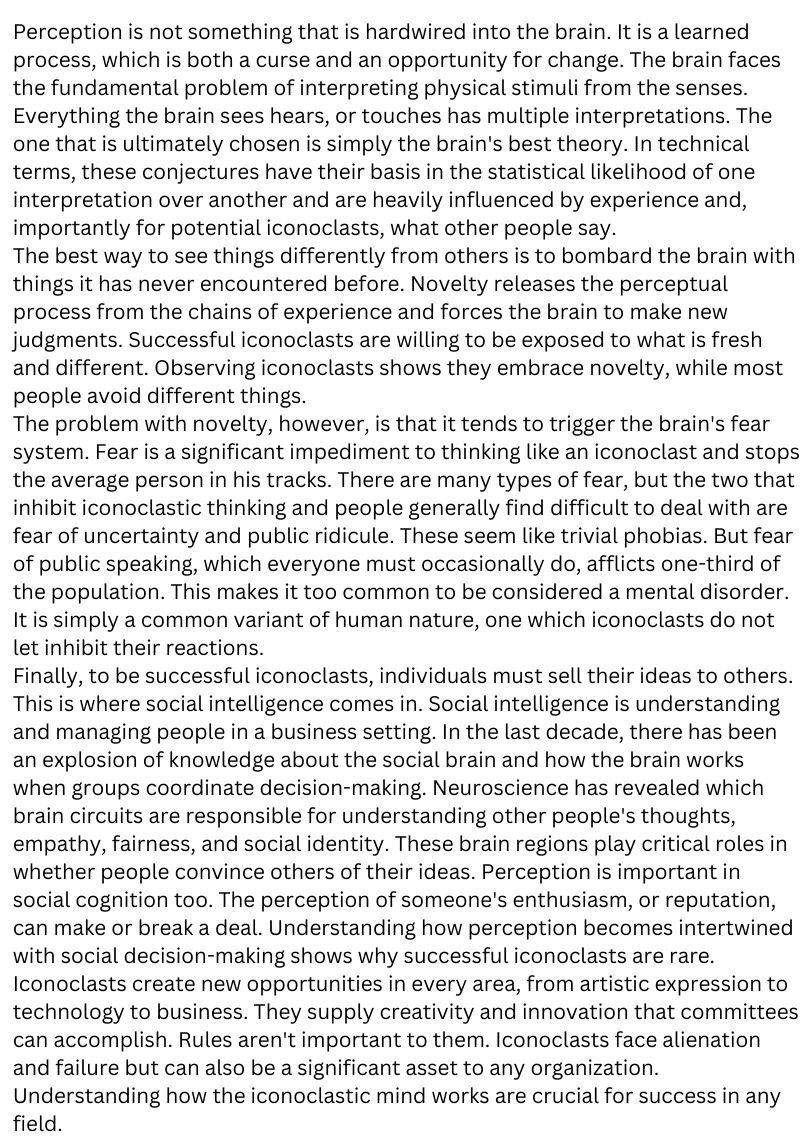
Tonyenglish.vn A neuroscientist reveals how to think differently
March 7, 2013. Easy-to-read book from a neuroscientist that argues how people can think differently and help their brains overcome our natural and learned behaviors that prevent innovation. The book includes many accessible case studies and examples from business and popular culture.

IELTS 9 READING TEST 2 PASSAGE 3 A Neuroscientist Reveals How To Think Differently Passage
"In order to think creatively, and imagine possibilities that only iconoclasts do, one must break out of the cycle of experience-dependent categorization-or what Mark Twain called "education." For most people, this does not come naturally. Often the harder one tries to think differently, the more rigid the categories become.
/cdn.vox-cdn.com/uploads/chorus_image/image/61810835/0.0.jpg)
A neuroscientist explains the limits and possibilities of using technology to read our thoughts
Questions 27-31. Choose the correct letter A. B. CorD.. Write the correct letter in boxes 27-31 on your answer sheet.. 27. Neuroeconomics is a field of study which seeks to. A. cause a change in how scientists understand brain chemistry. B. understand how good decisions are made in the brain. C. understand how the brain is linked to achievement in competitive fields.

Giải IELTS Reading Cambridge 9 Test 2 Passage 3 A NEUROSCIENTIST REVEALS HOW TO THINK
June 19, 2019 by IELTSdeal This IELTS Reading post focuses on all the solutions for IELTS Cambridge 9 Test 2 Reading Passage 3 which is entitled 'A neuroscientist reveals how to think differently' . This is a post for candidates who have major problems in finding Reading Answers.

A Neuroscientist reveals how to think differently Reading Answers And Question
Reading Task 3 A neuroscientist reveals how to think differently In the last decade a revolution has occurred In the way that scientists think about the brain. We now know that the decisions humans make can be traced to the firing patterns of neurons in specific parts of the brain.

Iconoclast A Neuroscientist Reveals How to Think Differently Harvard Business Publishing
1. Answer - C. Explanation: The answer to this question may be found in Paragraph A of A Neuroscientist Shows How to Think Differently Reading Answers IELTS sample.Toward the beginning of the paragraph, the author talks about neuroeconomics. According to the author, this field of science is all about the brain's success in an economic environment to adapt to innovation.

CAMBRIDGE IELTS 9 TEST 2 PASSAGE 3 A NEUROSCIENTIST REVEAL HOW TO THINK DIFFERENTLY IELTSOLOGY
A Neuroscientist Reveals How to Think Differently In the last decade, a revolution has occurred in the way that scientists think about the brain. We now know that the decisions humans make can be traced to the firing patterns of neurones in specific parts of the brain.

Cambridge IELTS 9, Test 2, Reading Passage 3 A Neuroscientist Reveals How to Think Differently
A Neuroscientist Reveals How to Think Differently Reading Answers comprises of question types; choose the correct answer, Yes/No/Not Given, and Sentence Completion. The time allocated to complete this IELTS Reading answer assessment is 20 minutes.

A Neuroscientist Reveals How To Think Differently Ielts Answer Pedalaman
Citation. Kelman, Steven. "Challenges to Conventional Thinking Can Prompt Novel Ideas." Federal Computer Week. June 3, 2009. Imagine for a moment — before you continue reading this column — a sun setting over a beach. If you are like most people, you imagined the sun setting peacefully over shimmering blue water, with the beach empty and.

IELTS9 A neuroscientist reveals how to think differently,TEST2,Reading answers YouTube
Start studying a neuroscientist reveals how to think differently. Learn vocabulary, terms, and more with flashcards, games, and other study tools.. "We think our perceptions of the world are real, but they are only biological and electrical rumblings.". Cam 12 Test READING PASSAGE 1 CORK. 31 terms. quizlette6305692. reducing the effect of.

Đáp Án Và Giải Thích A Neuroscientist Reveals How To Think Differently IELTS Reading Practice
A Neuroscientist Reveals How to Think Differently: Reading Answers Rajit Kaushal Last updated: January 24, 2023 IELTS Academic Test - Passage 06: A Neuroscientist Reveals How to Think Differently reading with answers explanation, location and pdf summary.

A Neuroscientist Shows How to Think Differently IELTS Reading Answers Sample
A Neuroscientist Reveals How to Think Differently- IELTS Reading Answers is from an academic reading passage that consists of 14 questions which have to be answered in 20 minutes. The Reading section of the IELTS exam can be your highest-scoring section, but only if you practise diligently.

[HT21DK4]Nguyễn Ngọc MaiReading 27/2A neuroscientist reveals how to think differently YouTube
A neuroscientist reveals how to think differently In the last decade a revolution has occurred In the way that scientists think about the brain. We now know that the decisions humans make can be traced to the firing patterns of neurons in specific parts of the brain.

NeuroScientist Reveals How to Think Differently// IELTS Reading//English With Sharmin YouTube
Today I will show you ielts 9 reading test 2 passage 3 answer with explanation.In this video A Neuroscientist Reveals How To Think Differently passage answe.

A Neuroscientist Reveals How to Think Differently basic reading Studocu
"In order to think creatively, and imagine possibilities that only iconoclasts do, one must break out of the cycle of experience-dependent categorization-or what Mark Twain called "education." For most people, this does not come naturally. Often the harder one tries to think differently, the more rigid the categories become.

Neuroscientist reveals the three things we should all be doing for a healthier brain TrendRadars
In Iconoclast, neuroscientist Gregory Berns explains why. He explores the constraints the human brain places on innovative thinking, including fear of failure, the urge to conform, and the tendency to interpret sensory information in familiar ways.Through vivid accounts of successful innovators ranging from glass artist Dale Chihuly to.